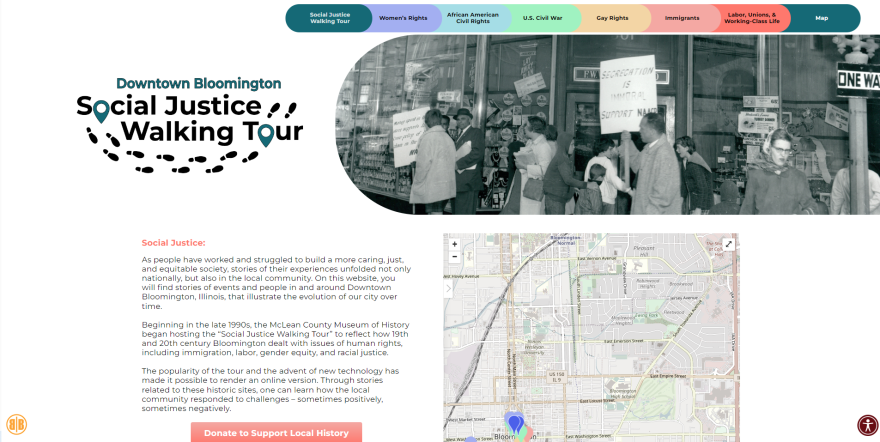A long-running tour highlighting social justice movements in downtown and west Bloomington is now available online.
McLean County Museum of History has created a new digital version of its popular Social Justice Walking Tour, developed in partnership with the Bloomington-Normal chapter of Not In Our Town. The website points out key locations where historical events related to gender and racial equality, organized labor and other social causes took place.
In addition to illuminating local stories for “townies,” the McLean County Museum of History considers the Social Justice Walking Tour to be a kind of outdoor exhibit that has the ability to draw mass appeal for out-of-towners, too.
“The story we tell here is certainly the story of Bloomington-Normal,” said Bill Kemp, the museum’s librarian. “But it’s also the story of central Illinois, Illinois, the Midwest and also the United States.”
Kemp and community activist and historian Mike Matejka frequently give live versions of the tour and take their stories into schools. Matejka has led some variation of the tour for nearly 25 years to illuminate the diversity of Bloomington-Normal.
“There are multiple strands to the quilt we call Bloomington-Normal,” he said. “Hopefully, everybody in the community sees some reflection of themselves.”
The new, interactive Social Justice Walking Tour website allows people to access the tour anytime, anywhere. It was created with funding from Under Our Wing, a local grant program administered by Bloomington-based Business Builders Marketing. Illinois Humanities Council and Healing Illinois provided additional funding.
Among the locations highlighted on the website is Dr. Herman Schroeder’s Opera House that once stood where the low-rise 1990s brick building containing The Pantagraph sits. Schroeder was notorious for hosting provocative guests.
“Frederick Douglass was here on more than one occasion,” Matejka said. The Opera House also hosted Victoria Woodhull, a suffragist who ran for president in the 1872 election.
“Victoria believed in free love and women choosing their own partners,” said Matejka. Refused a platform at another venue in town, Schroeder jumped at the chance to host Woodhull.
Susan B. Anthony was another visitor to the Opera House.
“Women were fighting for the right to vote throughout the 19th century and we see that in Bloomington,” Kemp said. Illinois women were granted the right to vote for school officers in 1891 (22 years before the 19th Amendment gave full voting rights to women nationwide).
“A debate is held at Schroeder’s Opera House between Edwin Hewett, a professor at Illinois State Normal University, soon to become president of the university, and Susan B. Anthony,” said Kemp. “Two years later, the Illinois Women’s Suffrage Association meets at the opera house and again Susan B. Anthony is there to give one of the addresses.
On the other side of museum square at the corner of Center and Jefferson Streets is the Illinois House building, once Bloomington’s premier hotel, the Ashley House. From ledgers and guest books archived at the history museum, it is clear that Ashley House was an integrated establishment (Frederick Douglass was one notable guest), but by the 1920s, Black patrons were no longer welcome.
“When people like Duke Ellington and Cab Calloway are coming to town to perform, they have to sleep on somebody’s couch,” said Matejka. “So, a question to ask is, what happened? Why were African American folks able to stay in the nicest hotel in the 19th century, but not the 20th? In a sense, that struggle to achieve equality after the Civil War gives African Americans real standing in this community, and by the 1920s, they are second-class citizens. So, this idea that human rights always go upward — it’s wonderful, that’s true, but we can’t always presume that it’s going to happen.”
The Social Justice Walking Tour interactive map and stories are available online at blono-social-justice-tour.org. A live tour with Mike Matejka and Bill Kemp will take place June 1, available to 25 registrants. A few spots remain, claimed by registering online.


